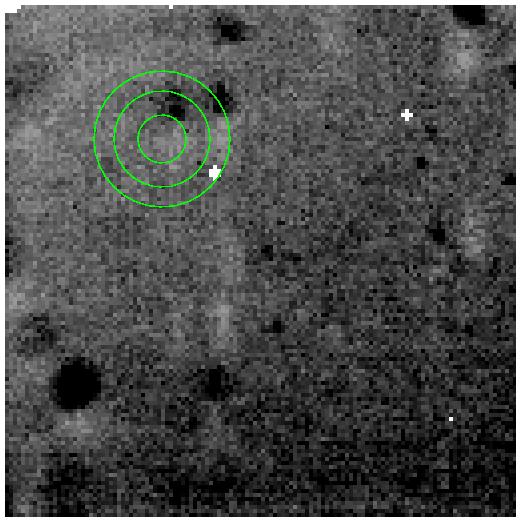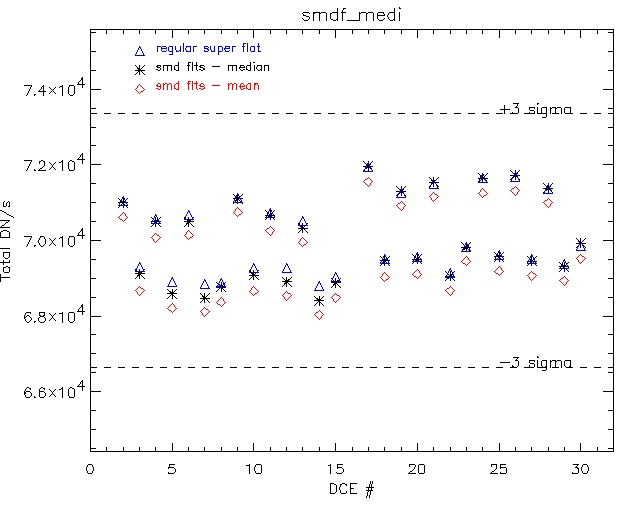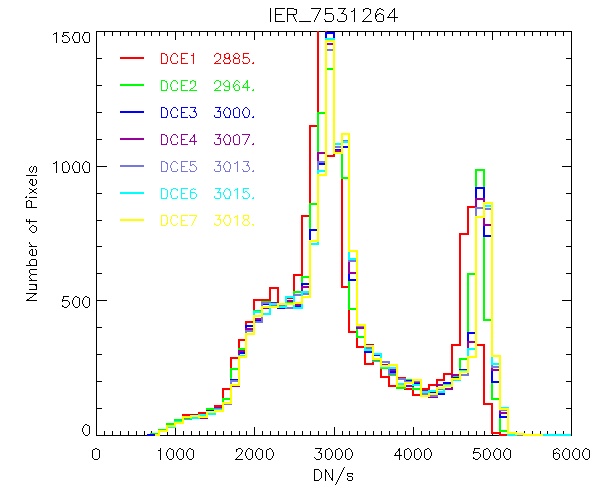
Figure 1: The ratio between one of the s.m.d. flats and regular super flat. The three green circles mark the target aperture and sky annulus.
Principal:
Deputy:
Analyst:
AORKEYS:
Last Updated:
As expected, this task generated a total of 30 Si:As DCEs on the star and 7 more in the stim IER. Using the scan mirror dependent (s.m.d.) flats, the dark spots caused by dusts on pick-up mirror have been correctedly flat-fielded.
As reported in the MIPS-920 Campaign J , the photometry obtained with scan mirror dependent (s.m.d.) super flats is systematically lower (<1%) than the photometry obtained with regular super flat. The ratio between one of the s.m.d. flats and the super flat (displayed in Figure 1) shows that the area where the target located has slightly higher values than 1. The dark spots, which always give lower values in the data, will bias the area outside the dark spots to higher values if the array is normalized to the mean value of the array. This might be reflecting a "problem" in the normalization of flat field creation.

Figure 1: The ratio between one of the s.m.d. flats and regular super flat. The three green circles mark the target aperture and sky annulus.
After discussed with Karl Misselt, Jane Morrison and Pablo Pérez-González, we realized that the default normalization mode in mips_enhancer is using "mean", and a switch "-FD" should be used if wish to use "median" for normalization instead. A new set of the s.m.d. flats was generated with the "-FD" option and tested it out on the data. The results are shown in Figure 2. The photometry obtained with the new s.m.d. flats are very close to the one with regular flats. There is no systematic offset between regular flat and the new median s.m.d. flats.

Figure 2: Aperture photometry for each of 30 DCEs with different flats.
The average total counts from the 28 DCEs (ignore the bias boost DCEs) is 7.000e+04 ± 1.116e+03 (1.59%) DN/s. This gives the conversion factor (from DN/s to Jy) 1.49e5, which is, again, very similar to what measured in the other campaigns. The WCS in the headers is still off by a few pixel for several DCEs, therefore, the coadded image is still using offset list with mips_enhancer.
The stimulator IER behaved as expected, producing 7 images of the flat-field stimulator. Figure 3 shows the historgram over the whole array in individual DCE. The 5-sigmaclip mean value is also listed in each DCE. (Note that 1st DCE has SUR on-board algorithm wrong, so the statistics from DCE#1 should be ignored.)

Figure 3: Histrogram on the Stim over DCEs
The flux calibration is delivered in this writeup.